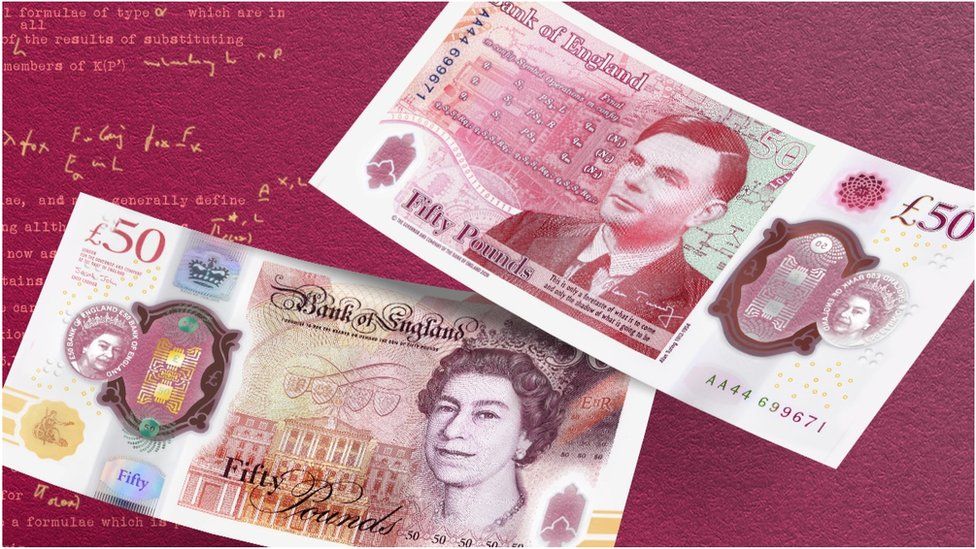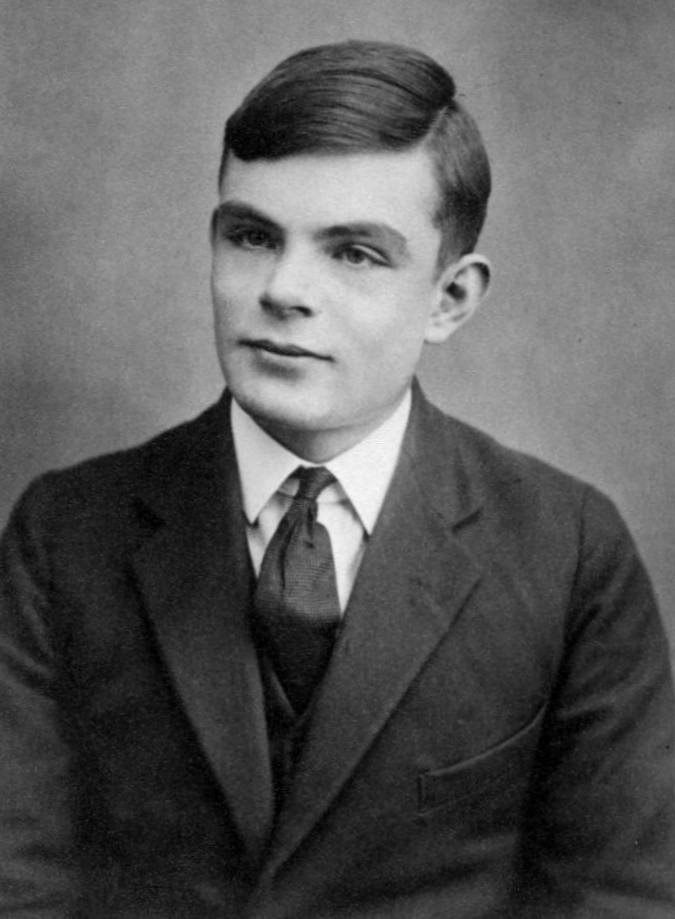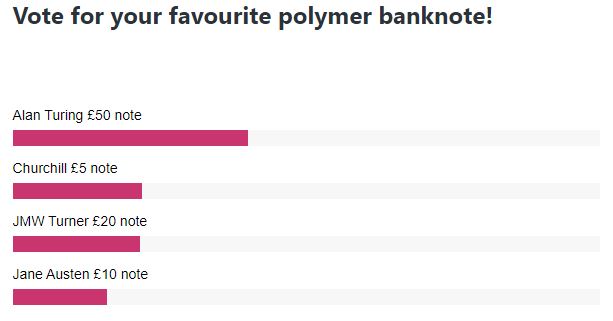Posts Tagged ‘Plastic Banknote’
Alan Turing – The Face of the £50 Note!
In 2019, The Bank of England revealed Alan Turing as the new face of the £50 banknote.
In their search to find an eminent British scientist to feature on the £50 note, a total of 227,299 nominations were sent to The Bank of England. 989 eligible characters were narrowed down to a shortlist of just 12 before Turing was finally selected.
Change Checker is so excited to reveal that today the design of this BRAND NEW £50 note has been officially confirmed by The Bank of England.

In keeping with Turing’s code-breaking legacy, this brand new £50 has been declared as the most secure yet.
What features on the new £50 note?

This brand new banknote is FULL of exciting features. Including:
- A photo of Turing from 1951 which is part of the National Portrait Gallery’s collection
- A table and mathematical formulae from Turing’s 1936 paper “On Computable Numbers, with an application to the Entscheidungsproblem”
- A design of Turing’s trial model of his famous Automatic Computing Engine (ACE) Pilot Machine
- Technical drawings for the British Bombe, one of the primary tools used to break Enigma-enciphered messages
- A quote from Turing, from an interview in The Times newspaper (June 1949): “This is only a foretaste of what is to come, and only the shadow of what is going to be”
- His signature from the visitor’s book at Max Newman’s House in 1947 which is on display at Bletchley Park
- Ticker tape depicting Alan Turing’s birth date (23 June 1912) in binary code.
In addition to these amazing design features, there are of course a series of security features, similar to those we’ve seen on our £5, £10, and £20 polymer notes, including holograms and see-through windows.
GCHQ Collaboration
In recognition of Turing’s code-breaking expertise, the Bank of England have collaborated with GCHQ on the intelligence and cyber agency’s toughest puzzle ever – based on the Turing £50 bank note design.
GCHQ’s Turing Challenge is a set of 12 puzzles that have been put together by intelligence staff at GCHQ, where problem solving and a diverse mix of minds are at the heart of its work to help protect the UK from increasingly complex threats
Who was Alan Turing and why is he being featured on a £50 note?

Alan Turing was most famously known for accelerating Allied efforts to read German Naval messages enciphered with the Enigma machine.
His work is said to have been key to shortening World War Two and saving millions of lives.
In addition to his work during World War Two, Turing played a pivotal role in the development of early computers, first at the National Physical Laboratory and later at the University of Manchester.
In 2013, he was given a posthumous royal pardon for his 1952 conviction for gross indecency.
Speaking of the new note, Andrew Bailey, the governor of the Bank of England, said: “Turing was a leading mathematician, developmental biologist, and a pioneer in the field of computer science. By placing him on our new polymer £50 banknote, we are celebrating his achievements, and the values he symbolises.”
Polymer Notes

This brand new £50 note is the last in the Bank of England’s collection to switch from paper to polymer, following the popularity of the polymer £20, £10 and £5 notes.
The banknote will enter circulation on 23 June, which would have been the mathematician’s birthday.
Alan Turing £50 note voted as Change Checker’s favourite polymer note!
As the brand new £50 note is the last in the Bank of England’s collection to switch from paper to polymer, we asked you to vote for your favourite polymer note.
The results are in!

The Alan Turing £50 has been revealed as Change Checkers’ favourite polymer banknote, taking over 40% of the votes!
We’re certain collectors will be eager to add this banknote to their collections when it’s released later in the year. Will you? Let us know in the comments below!
Don’t miss out on the very latest UK coin releases!

Join the Change Checker UK CERTIFIED BU Subscription Service and receive new UK coins sent to your door without the hassle of placing orders on the day of release!
Simply choose the perfect subscription for you here >>
The History of the UK Banknote…
The UK banknotes have gone through some big changes since they were first introduced but do you know the story behind them?
In this blog, we guide you through the history of UK banknotes as we take a look at just how far they’ve come…

7th Century – China
The first recorded use of ‘paper’ money was in China back in the seventh century! However, it was until over a thousand years later that paper money made its way to Europe.
16th Century – Goldsmith-Bankers
In the 16th century, the goldsmith-bankers would issue receipts for cash, known as ‘running cash notes’. They were made out in the name of the depositor and also carried the words, ‘or bearer’, after the name of the depositor.
This similar phrase still appears on British banknotes today: “I promise to pay the bearer on demand the sum of…”
1694 – Bank of England
When the Bank of England was established in 1694 to raise money for King William III’s war effort, they issued notes in exchange for deposits. These were the first recorded bank notes to feature a cashier’s signature!
18th Century – Fixed Denominations
The issuing of fixed denomination notes first started in the 18th century. Notes were printed with the pound sign and the first digit included, but any following digits were then added by hand!
By 1745, notes were issued in denominations ranging from £20 to £1,000 but it wasn’t until 1759, as a result of gold shortages caused by the seven years of war, that a £10 note was issued.
The £5 note followed in 1793 at the start of the war against Revolutionary France and by 1797 the £1 and £2 notes were issued.
1853- Fully Printed
In 1853, the first fully printed banknotes were introduced, meaning hand-written denominations on notes were phased out.
Early 20th Century – 10 Shilling Note
During the First World War, the link between notes and gold was broken. The government needed to preserve bullion stocks and so the Bank stopped paying out gold for its notes.
In 1914 the Treasury printed and issued 10 shilling and £1 notes and in 1931, Britain left the gold standard.
Late 20th Century – Feature of Historical Figures
The late 20th century saw the first introduction of historical figures on the designs of UK banknotes. Since 1970, we’ve seen figures including scientist Isaac Newton, composer Edward Elgar and nurse Florence Nightingale featured on our banknotes.
21st Century – Polymer notes and BAME figures
In the 21st century we have seen the introduction of the polymer £5, £10 and £20 banknote, as a cleaner, safer and stronger alternative to the paper notes.
These notes have become incredibly popular with collectors, with some polymer £20 notes fetching far over their face value on the secondary market!
However, a lack of Black, Asian and Minority Ethnic (BAME) figures being recognised on legal tender led to campaigning for greater inclusivity in 2020.
These campaigns come after Chancellor Rishi Sunak stated he was considering proposals from a campaign group. He has since asked the Royal Mint to come up withnew designs honouring BAME figures who have served the nation – such as military figures and nurses.
Whilst details of these figures and designs remain under consideration, we look forward to hearing more as the story unfolds.
Did you know how far back in history our banknotes date? Let us know in the comments below!
Secure the last-ever £1 banknote to your collection!
Click here to secure your piece of British Numismatic history for just £10 (+p&p) >>
First look – the new Churchill £5 note revealed…
The new £5 note features an image of Sir Winston Churchill, alongside the famous quotation from his first speech as Prime Minister: ‘I have nothing to offer but blood, toil, tears and sweat.’
In the background the clock on Queen Elizabeth’s Tower reads 3pm, the time Churchill was making his speech in 1940. Behind the Houses of Parliament you can see the Nobel Prize for literature which the great statesman won in 1953.
The other side of the note features a raft of new security measures including a see-through window, multiple holograms and micro-lettering under the Queen’s portrait – which can only be viewed under a microscope.But most importantly…
When can I find one in my change?
The new note will enter circulation on September 13th this year. However, with millions of existing five pound notes still in use you may not be able to find one straight away.
Will I still be able to spend my current £5 notes?
Yes you will, but only up until May 2017. After that, they will cease to be legal tender – but you will still be able to exchange them at the Bank of England.
So the new era of Plastic Banknotes is officially upon us! What do you make of the new design? Let us know on Facebook or Twitter or in the comments below.
 You can Find, Collect and Swap all of the UK commemorative coins you find in your change for free on the Change Checker Web App… try it here now: www.changechecker.org/app
You can Find, Collect and Swap all of the UK commemorative coins you find in your change for free on the Change Checker Web App… try it here now: www.changechecker.org/app



